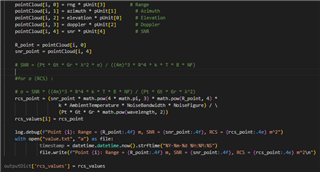Tool/software:
Hello Officer,
I am currently working on TI’s AWR683AOP demo within the Industrial Toolbox, specifically focusing on the vital signs with tracking project. My objective is to calculate and estimate the Radar Cross Section (RCS) using the SNR data obtained from the demo’s point cloud information. My approach to estimating RCS from the measured SNR is based on the well‐known radar equation for a monostatic configuration. As a reminder, the relationship I’m using is as follows:
I want to be sure that my approach is true or not. I found there is relationship between SNR and RCS. If we know SNR, then the RCS can be derived. I am trying to obtain rcs data using this SNR value.

Which can be rearranged to solve for the Radar Cross Section (RCS),

My plan is to extract the SNR value from the TLV data. In our implementation, each point’s data is decompressed (using the scaling factors from pUnit) and the SNR is calculated as:
pointCloud[i,4] = snr * pUnit[4] # SNR for the i-th point (in ParseTLVs.py) Once I have the SNR and range for each point, I compute the RCS for that point with:

k * T * B * NF) / (P_t * G_t * G_r * math.pow(wavelength, 2))
Thank you for your time and consideration.
Best regards,

